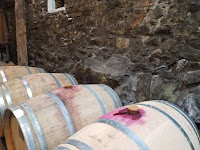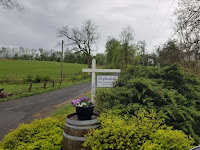 I've planned to visit more distilleries in 2023 and Filibuster Distillery has been on my list for quite some time - ever since a tasting with Mr. Dilawri several years ago. And with the distillery located in the Shenandoah Valley between Strasburg and Woodstock, there are several other craft beverage establishments and small towns to explore before or after the visit. Filibuster leverages the limestone-filtered water that is prevalent in the valley and this water has a higher ratio of beneficial minerals than Kentucky limestone-filtered water. They also use a combination of native and cultured yeast as well as a pot and column still, all depending on the targeted spirit.
I've planned to visit more distilleries in 2023 and Filibuster Distillery has been on my list for quite some time - ever since a tasting with Mr. Dilawri several years ago. And with the distillery located in the Shenandoah Valley between Strasburg and Woodstock, there are several other craft beverage establishments and small towns to explore before or after the visit. Filibuster leverages the limestone-filtered water that is prevalent in the valley and this water has a higher ratio of beneficial minerals than Kentucky limestone-filtered water. They also use a combination of native and cultured yeast as well as a pot and column still, all depending on the targeted spirit. It was a quiet day on my visit and I had the full attention of the tasting room staff to learn about their innovative approach to using various used casks and the 2023 World Whisky Awards “Best Small Batch” Bourbon from outside of Kentucky: Bottled in Bond. This is a long way from the MGPI Rye that I first tasted long ago. In fact, the distillery sources all of its corn, rye, and barley from neighboring Shenandoah Valley farms. I chose the Premium Flight so that I could sample the Bottled in Bond and also two out of the limited-release Triple Cask series.
It was a quiet day on my visit and I had the full attention of the tasting room staff to learn about their innovative approach to using various used casks and the 2023 World Whisky Awards “Best Small Batch” Bourbon from outside of Kentucky: Bottled in Bond. This is a long way from the MGPI Rye that I first tasted long ago. In fact, the distillery sources all of its corn, rye, and barley from neighboring Shenandoah Valley farms. I chose the Premium Flight so that I could sample the Bottled in Bond and also two out of the limited-release Triple Cask series.  Bottled In Bond is a Federal designation encapsulated in the Bottled-in-Bond Act of 1897 -- introduced to ensure that whiskey producers were making their whiskey at a certain quality level and standard suitable for the public. Before the regulation, distillers would add additives and even spit chewing tobacco to color the spirit and add oak aging characteristics. In order to be labeled as bottled-in-bond or bonded, the product must be (1) made at a single distillery, (2) produced within a single distilling season, (3) aged for a minimum of four years at a federally bonded warehouse, and (4) bottled at 50% ABV. The Filibuster Bottled in Bond Bourbon Whiskey ($79.99) was created following these rules and shows a little heat at that proof, but a couple drops of water dampen the alcohol and lift the honeyed orange aromas. The palate and finish carry smoked caramel and little candied nuts.
Bottled In Bond is a Federal designation encapsulated in the Bottled-in-Bond Act of 1897 -- introduced to ensure that whiskey producers were making their whiskey at a certain quality level and standard suitable for the public. Before the regulation, distillers would add additives and even spit chewing tobacco to color the spirit and add oak aging characteristics. In order to be labeled as bottled-in-bond or bonded, the product must be (1) made at a single distillery, (2) produced within a single distilling season, (3) aged for a minimum of four years at a federally bonded warehouse, and (4) bottled at 50% ABV. The Filibuster Bottled in Bond Bourbon Whiskey ($79.99) was created following these rules and shows a little heat at that proof, but a couple drops of water dampen the alcohol and lift the honeyed orange aromas. The palate and finish carry smoked caramel and little candied nuts.  I also chose the Triple Cask Finished In Madeira Barrels ($79.99) and Triple Cask Finished In Sherry Barrels ($79.99) which both utilize a 6- year-old high Rye bourbon from MGPI and a 5-year-old Sweet Mash Filibuster Straight Bourbon as a base before finishing in the respective cask for 11 months. Both also weigh in between 114 to 117 proof but show less heat than the 100 proof Bottled in Bond. That being said, a couple drops of water still tames any lingering alcohol and elevates the nose with what one would expect from a Madeira or Sherry. Lots of dried fruit, nuts, figs, and some caramel and honey. Both are very savory.
I also chose the Triple Cask Finished In Madeira Barrels ($79.99) and Triple Cask Finished In Sherry Barrels ($79.99) which both utilize a 6- year-old high Rye bourbon from MGPI and a 5-year-old Sweet Mash Filibuster Straight Bourbon as a base before finishing in the respective cask for 11 months. Both also weigh in between 114 to 117 proof but show less heat than the 100 proof Bottled in Bond. That being said, a couple drops of water still tames any lingering alcohol and elevates the nose with what one would expect from a Madeira or Sherry. Lots of dried fruit, nuts, figs, and some caramel and honey. Both are very savory.I was also invited to sample the Filibuster Dual Cask Straight Bourbon Whiskey ($48.99), which was the inspiration for the Triple Cask, but made at a slightly more approachable proof and a more approachable price point. The mash bill consists of 70% sweet corn, 20% rye, and 10% barley aged less than four years in American oak. The whiskey is then finished in used French wine barrels - I believe once filled with Chardonnay. The result is vanilla, caramel, and baking spices on the nose with the caramel remaining through the finish. Expect some cherry cola, banana, and candied apricots. Any heat dissipates rather quickly.














































